Epidemiology Study Designs and Critical Appraisal: PUBH6005 Report
VerifiedAdded on 2022/11/24
|29
|3891
|248
Report
AI Summary
This report delves into the field of epidemiology, providing a comprehensive analysis of various study designs, including Randomized Controlled Trials (RCT), cohort studies, and case-control studies. It begins with an introduction to epidemiology, defining its scope and importance in public health. The report then classifies different types of epidemiological studies, such as observational and experimental studies, and provides detailed explanations of each type, including their advantages and disadvantages. The core of the report involves a critical appraisal of three research articles, each employing a different study design, focusing on hypertension, coffee consumption during pregnancy, and ovarian cancer. The appraisal includes the application of critical appraisal checklists to evaluate the methodologies, results, and conclusions of each study. Furthermore, the report explores the concepts of association and causation, statistical and public health significance, and the potential for bias, confounding, and chance errors in epidemiological studies. The report concludes with a discussion of the implications of the findings and their relevance to public health practice.
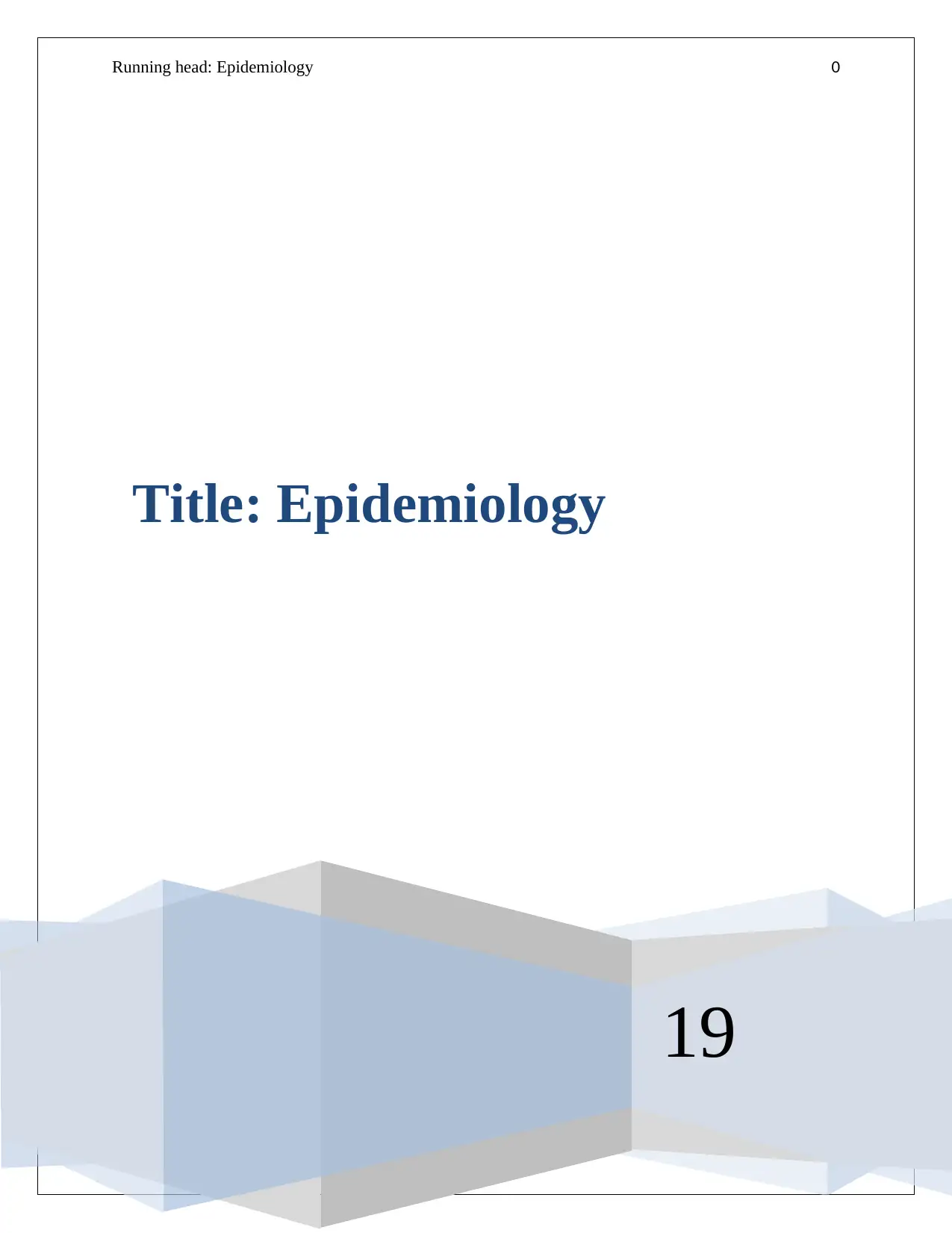
Running head: Epidemiology 0
19
Title: Epidemiology
19
Title: Epidemiology
Paraphrase This Document
Need a fresh take? Get an instant paraphrase of this document with our AI Paraphraser
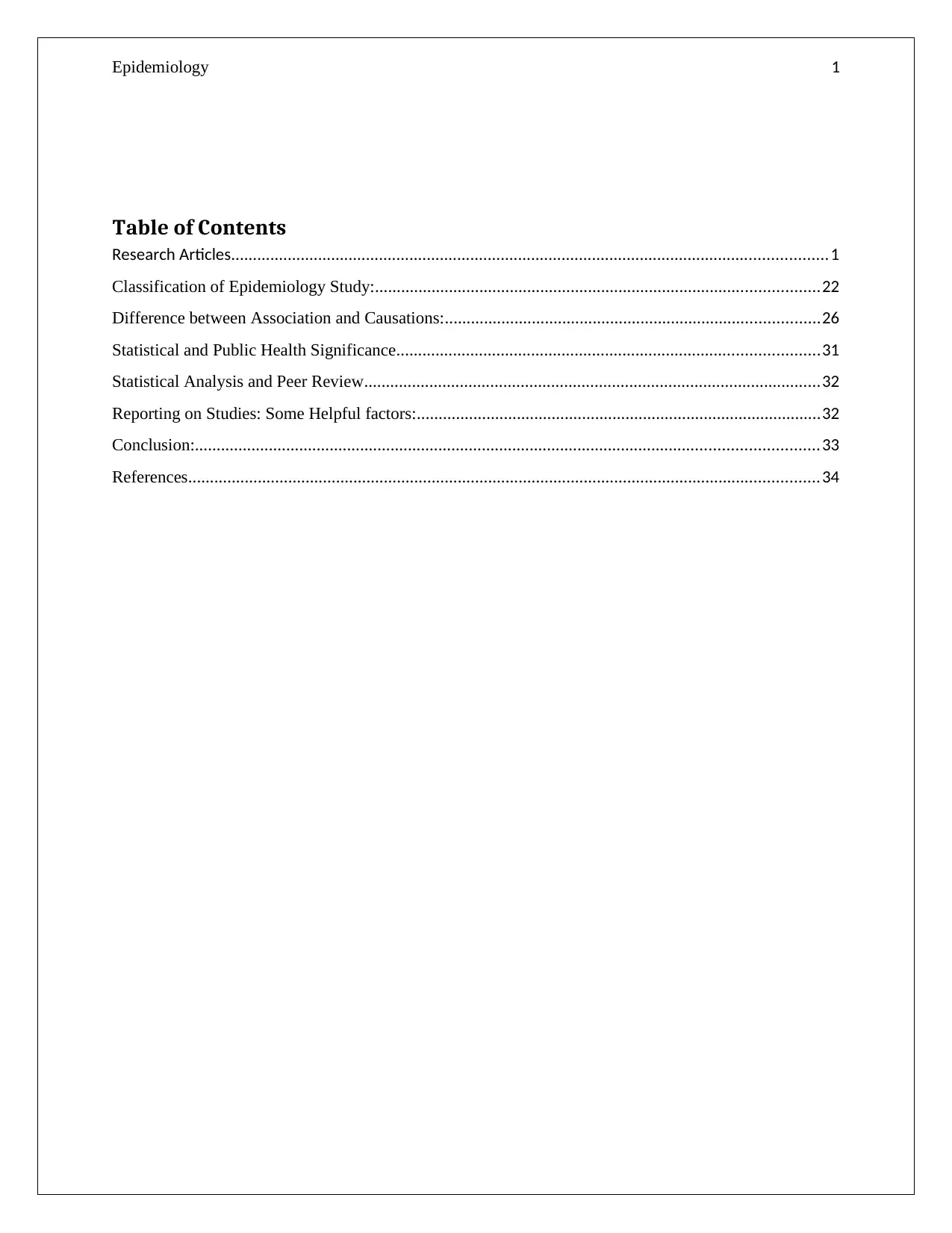
Epidemiology 1
Table of Contents
Research Articles.........................................................................................................................................1
Classification of Epidemiology Study:......................................................................................................22
Difference between Association and Causations:......................................................................................26
Statistical and Public Health Significance.................................................................................................31
Statistical Analysis and Peer Review.........................................................................................................32
Reporting on Studies: Some Helpful factors:.............................................................................................32
Conclusion:...............................................................................................................................................33
References.................................................................................................................................................34
Table of Contents
Research Articles.........................................................................................................................................1
Classification of Epidemiology Study:......................................................................................................22
Difference between Association and Causations:......................................................................................26
Statistical and Public Health Significance.................................................................................................31
Statistical Analysis and Peer Review.........................................................................................................32
Reporting on Studies: Some Helpful factors:.............................................................................................32
Conclusion:...............................................................................................................................................33
References.................................................................................................................................................34
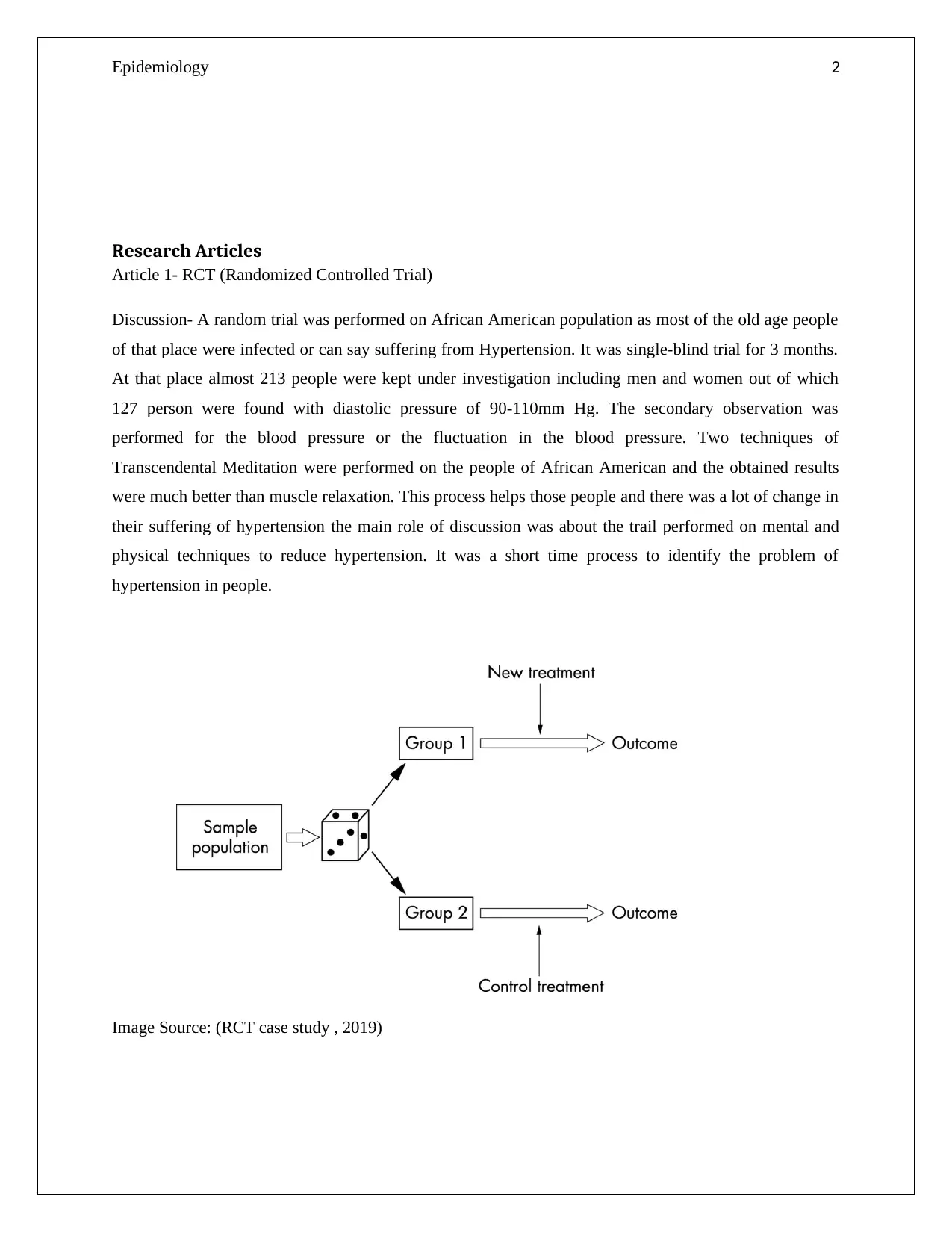
Epidemiology 2
Research Articles
Article 1- RCT (Randomized Controlled Trial)
Discussion- A random trial was performed on African American population as most of the old age people
of that place were infected or can say suffering from Hypertension. It was single-blind trial for 3 months.
At that place almost 213 people were kept under investigation including men and women out of which
127 person were found with diastolic pressure of 90-110mm Hg. The secondary observation was
performed for the blood pressure or the fluctuation in the blood pressure. Two techniques of
Transcendental Meditation were performed on the people of African American and the obtained results
were much better than muscle relaxation. This process helps those people and there was a lot of change in
their suffering of hypertension the main role of discussion was about the trail performed on mental and
physical techniques to reduce hypertension. It was a short time process to identify the problem of
hypertension in people.
Image Source: (RCT case study , 2019)
Research Articles
Article 1- RCT (Randomized Controlled Trial)
Discussion- A random trial was performed on African American population as most of the old age people
of that place were infected or can say suffering from Hypertension. It was single-blind trial for 3 months.
At that place almost 213 people were kept under investigation including men and women out of which
127 person were found with diastolic pressure of 90-110mm Hg. The secondary observation was
performed for the blood pressure or the fluctuation in the blood pressure. Two techniques of
Transcendental Meditation were performed on the people of African American and the obtained results
were much better than muscle relaxation. This process helps those people and there was a lot of change in
their suffering of hypertension the main role of discussion was about the trail performed on mental and
physical techniques to reduce hypertension. It was a short time process to identify the problem of
hypertension in people.
Image Source: (RCT case study , 2019)
⊘ This is a preview!⊘
Do you want full access?
Subscribe today to unlock all pages.

Trusted by 1+ million students worldwide
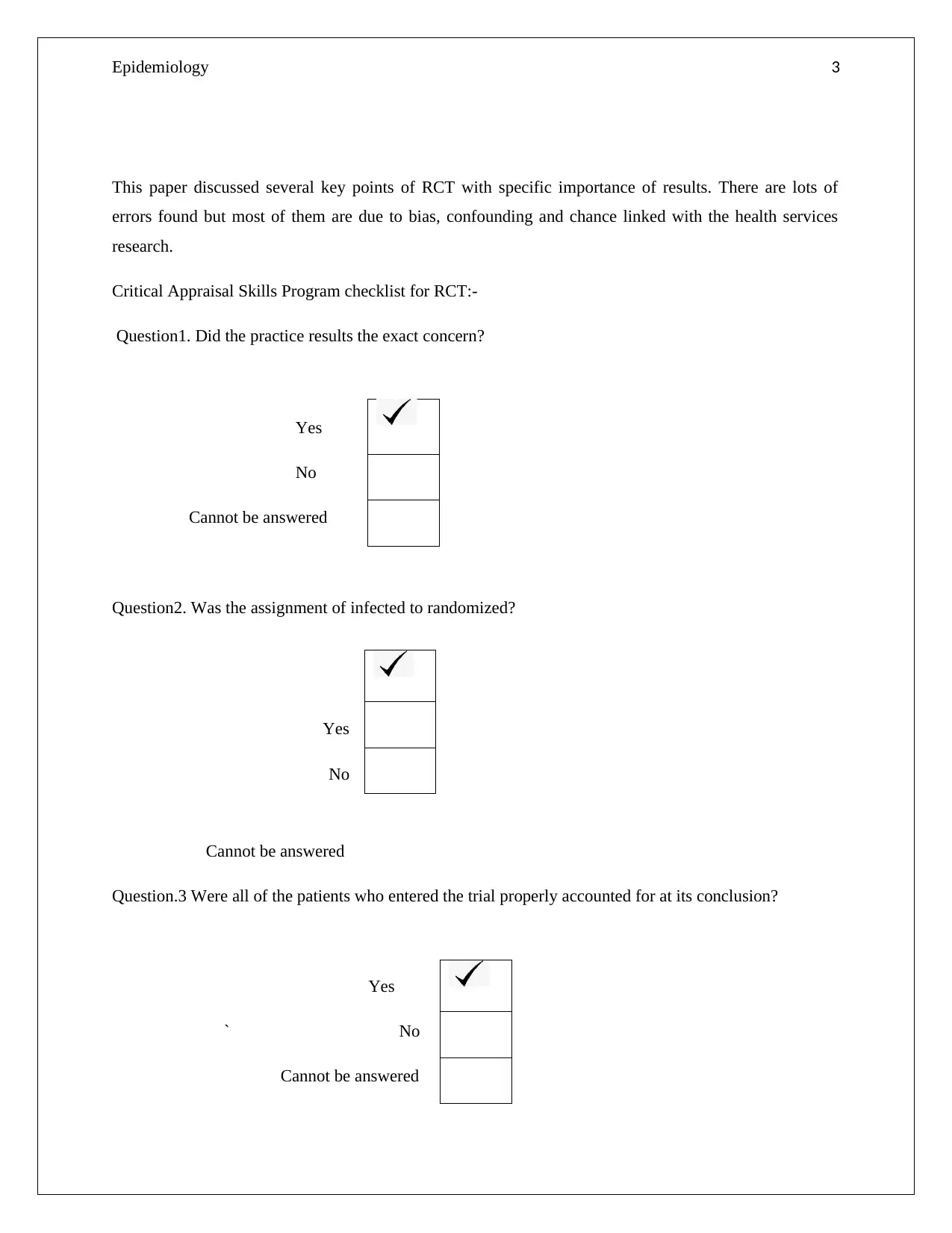
Epidemiology 3
This paper discussed several key points of RCT with specific importance of results. There are lots of
errors found but most of them are due to bias, confounding and chance linked with the health services
research.
Critical Appraisal Skills Program checklist for RCT:-
Question1. Did the practice results the exact concern?
Yes
No
Cannot be answered
Question2. Was the assignment of infected to randomized?
Yes
No
Cannot be answered
Question.3 Were all of the patients who entered the trial properly accounted for at its conclusion?
Yes
` No
Cannot be answered
This paper discussed several key points of RCT with specific importance of results. There are lots of
errors found but most of them are due to bias, confounding and chance linked with the health services
research.
Critical Appraisal Skills Program checklist for RCT:-
Question1. Did the practice results the exact concern?
Yes
No
Cannot be answered
Question2. Was the assignment of infected to randomized?
Yes
No
Cannot be answered
Question.3 Were all of the patients who entered the trial properly accounted for at its conclusion?
Yes
` No
Cannot be answered
Paraphrase This Document
Need a fresh take? Get an instant paraphrase of this document with our AI Paraphraser
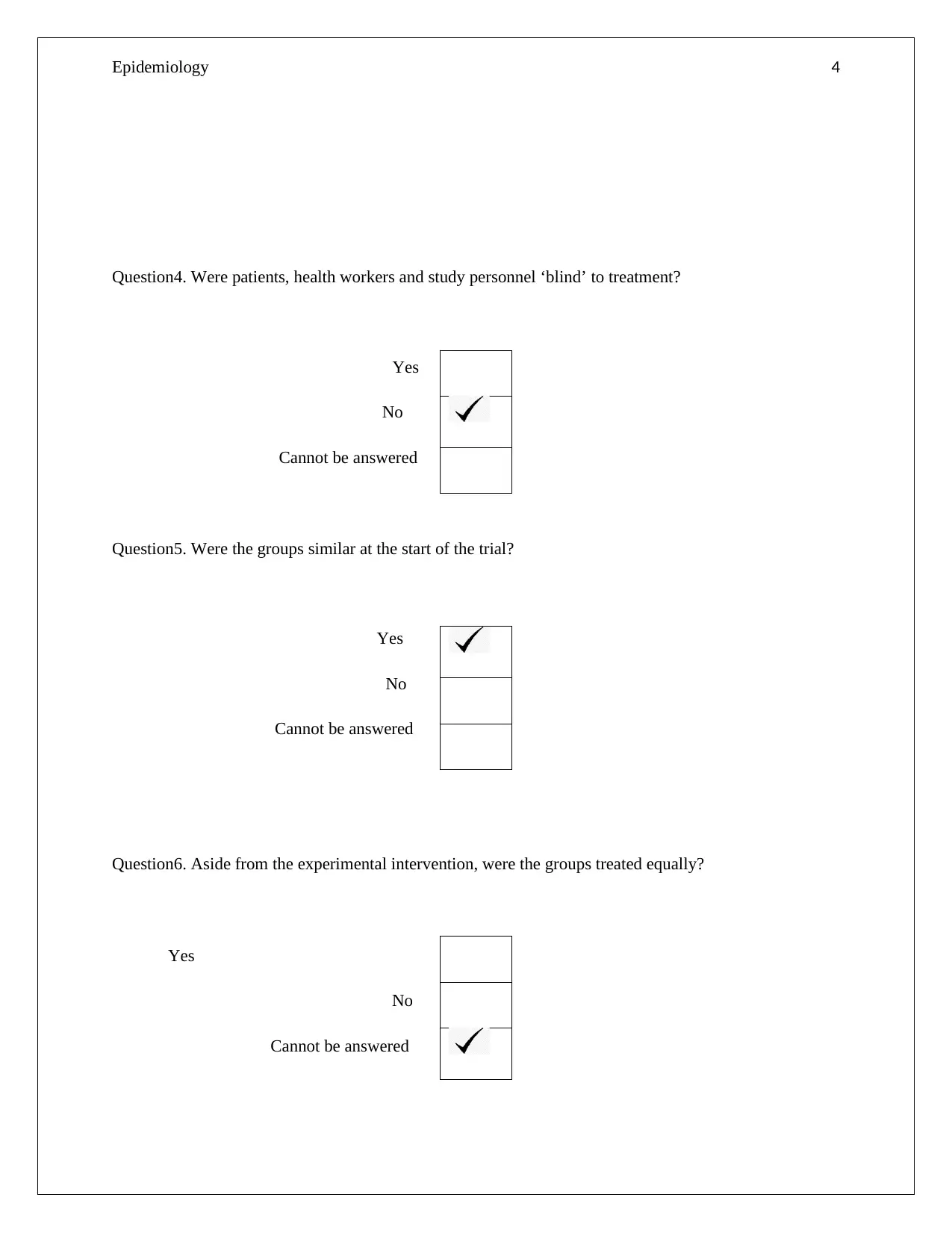
Epidemiology 4
Question4. Were patients, health workers and study personnel ‘blind’ to treatment?
Yes
No
Cannot be answered
Question5. Were the groups similar at the start of the trial?
Yes
No
Cannot be answered
Question6. Aside from the experimental intervention, were the groups treated equally?
Yes
No
Cannot be answered
Question4. Were patients, health workers and study personnel ‘blind’ to treatment?
Yes
No
Cannot be answered
Question5. Were the groups similar at the start of the trial?
Yes
No
Cannot be answered
Question6. Aside from the experimental intervention, were the groups treated equally?
Yes
No
Cannot be answered
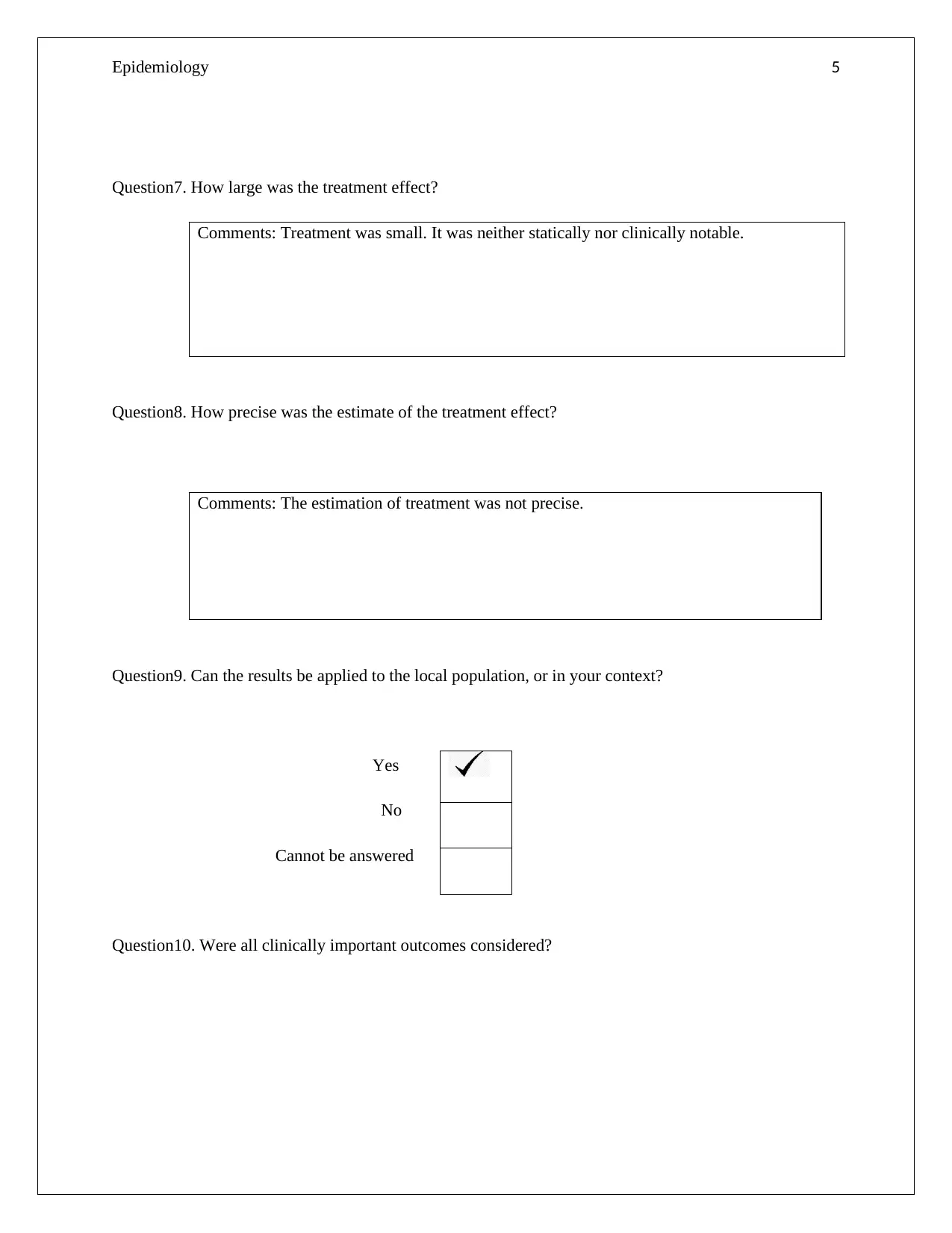
Epidemiology 5
Question7. How large was the treatment effect?
Comments: Treatment was small. It was neither statically nor clinically notable.
Question8. How precise was the estimate of the treatment effect?
Comments: The estimation of treatment was not precise.
Question9. Can the results be applied to the local population, or in your context?
Yes
No
Cannot be answered
Question10. Were all clinically important outcomes considered?
Question7. How large was the treatment effect?
Comments: Treatment was small. It was neither statically nor clinically notable.
Question8. How precise was the estimate of the treatment effect?
Comments: The estimation of treatment was not precise.
Question9. Can the results be applied to the local population, or in your context?
Yes
No
Cannot be answered
Question10. Were all clinically important outcomes considered?
⊘ This is a preview!⊘
Do you want full access?
Subscribe today to unlock all pages.

Trusted by 1+ million students worldwide
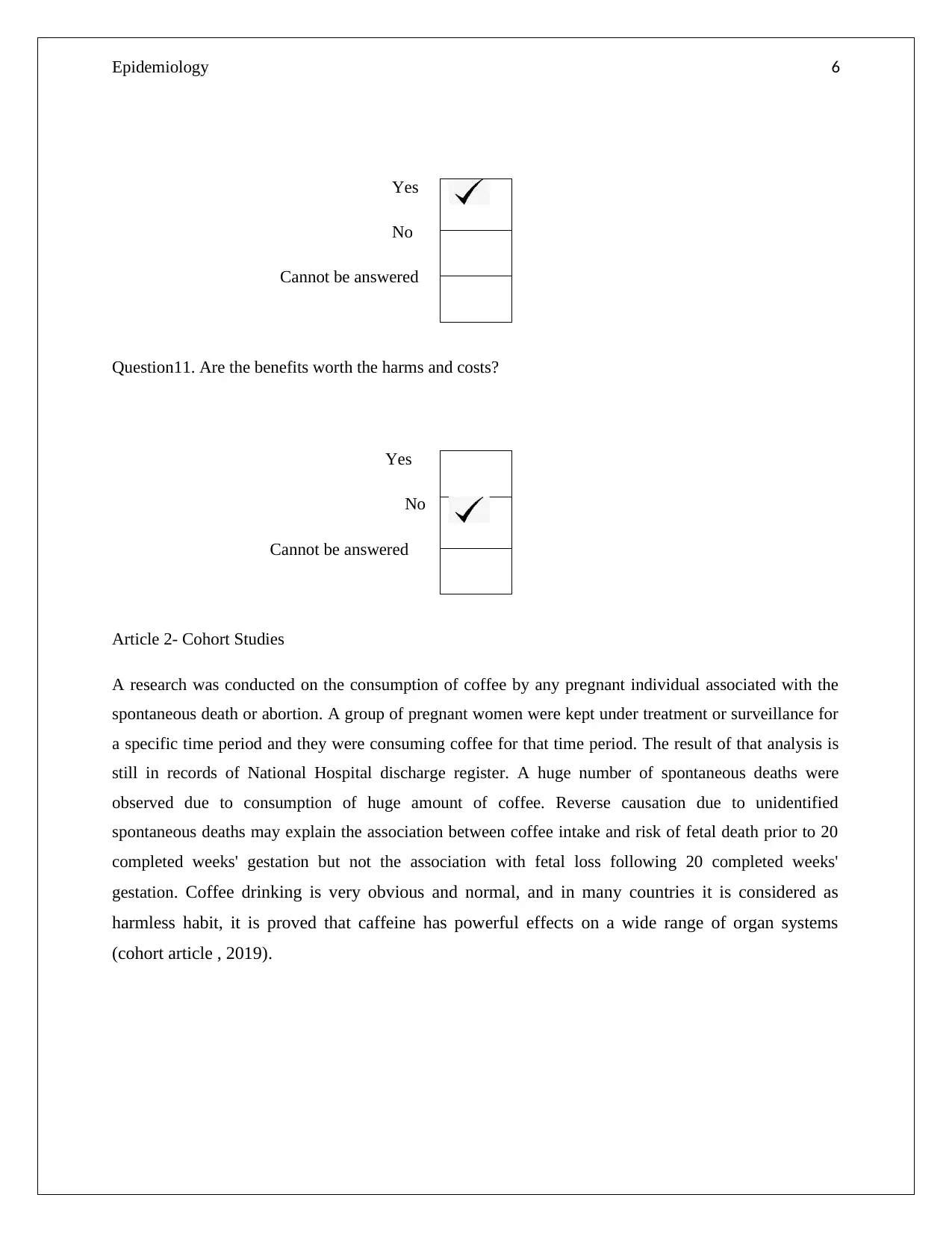
Epidemiology 6
Yes
No
Cannot be answered
Question11. Are the benefits worth the harms and costs?
Yes
No
Cannot be answered
Article 2- Cohort Studies
A research was conducted on the consumption of coffee by any pregnant individual associated with the
spontaneous death or abortion. A group of pregnant women were kept under treatment or surveillance for
a specific time period and they were consuming coffee for that time period. The result of that analysis is
still in records of National Hospital discharge register. A huge number of spontaneous deaths were
observed due to consumption of huge amount of coffee. Reverse causation due to unidentified
spontaneous deaths may explain the association between coffee intake and risk of fetal death prior to 20
completed weeks' gestation but not the association with fetal loss following 20 completed weeks'
gestation. Coffee drinking is very obvious and normal, and in many countries it is considered as
harmless habit, it is proved that caffeine has powerful effects on a wide range of organ systems
(cohort article , 2019).
Yes
No
Cannot be answered
Question11. Are the benefits worth the harms and costs?
Yes
No
Cannot be answered
Article 2- Cohort Studies
A research was conducted on the consumption of coffee by any pregnant individual associated with the
spontaneous death or abortion. A group of pregnant women were kept under treatment or surveillance for
a specific time period and they were consuming coffee for that time period. The result of that analysis is
still in records of National Hospital discharge register. A huge number of spontaneous deaths were
observed due to consumption of huge amount of coffee. Reverse causation due to unidentified
spontaneous deaths may explain the association between coffee intake and risk of fetal death prior to 20
completed weeks' gestation but not the association with fetal loss following 20 completed weeks'
gestation. Coffee drinking is very obvious and normal, and in many countries it is considered as
harmless habit, it is proved that caffeine has powerful effects on a wide range of organ systems
(cohort article , 2019).
Paraphrase This Document
Need a fresh take? Get an instant paraphrase of this document with our AI Paraphraser
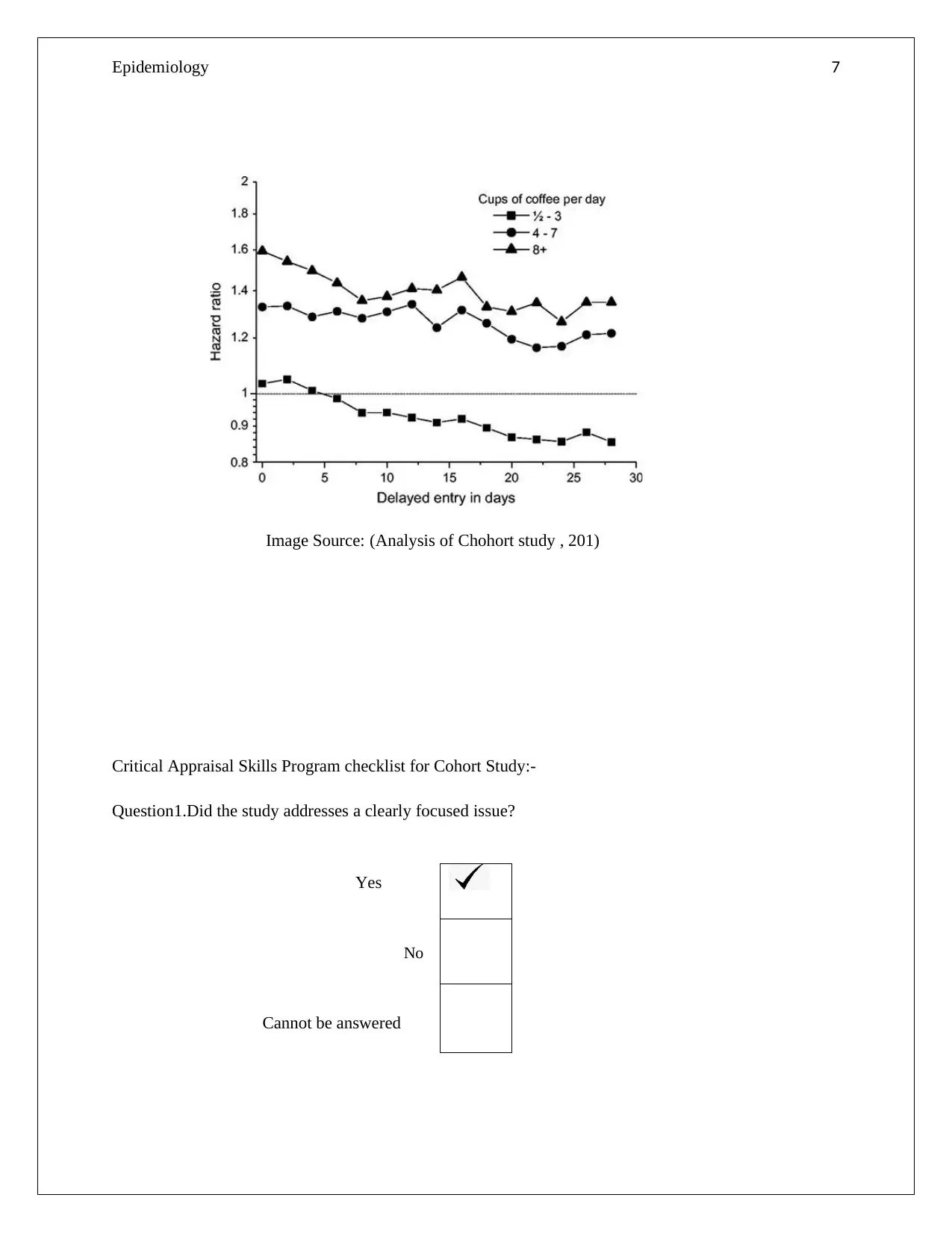
Epidemiology 7
Image Source: (Analysis of Chohort study , 201)
Critical Appraisal Skills Program checklist for Cohort Study:-
Question1.Did the study addresses a clearly focused issue?
Yes
No
Cannot be answered
Image Source: (Analysis of Chohort study , 201)
Critical Appraisal Skills Program checklist for Cohort Study:-
Question1.Did the study addresses a clearly focused issue?
Yes
No
Cannot be answered
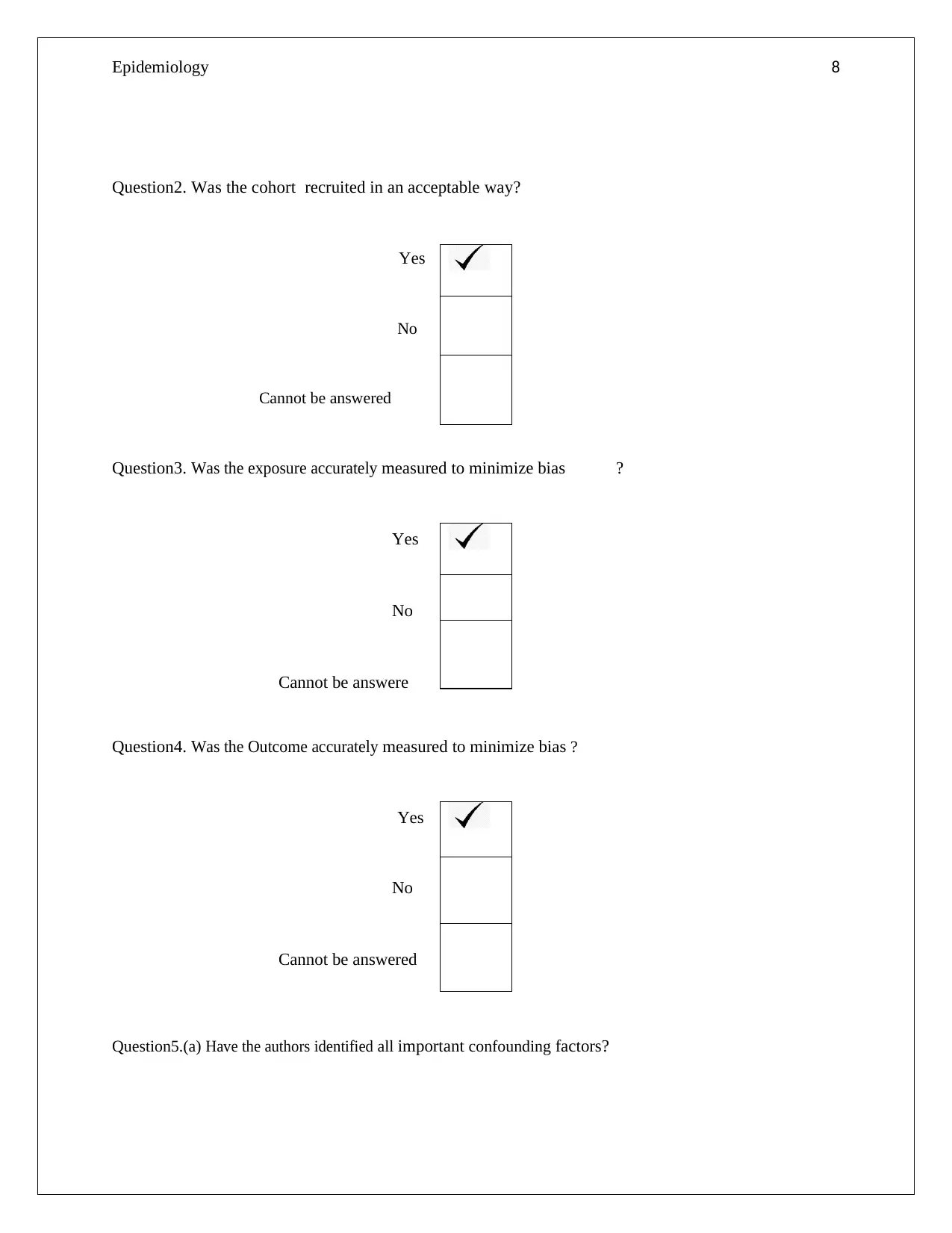
Epidemiology 8
Question2. Was the cohort recruited in an acceptable way?
Yes
No
Cannot be answered
Question3. Was the exposure accurately measured to minimize bias ?
Yes
No
Cannot be answere
Question4. Was the Outcome accurately measured to minimize bias ?
Yes
No
Cannot be answered
Question5.(a) Have the authors identified all important confounding factors?
Question2. Was the cohort recruited in an acceptable way?
Yes
No
Cannot be answered
Question3. Was the exposure accurately measured to minimize bias ?
Yes
No
Cannot be answere
Question4. Was the Outcome accurately measured to minimize bias ?
Yes
No
Cannot be answered
Question5.(a) Have the authors identified all important confounding factors?
⊘ This is a preview!⊘
Do you want full access?
Subscribe today to unlock all pages.

Trusted by 1+ million students worldwide
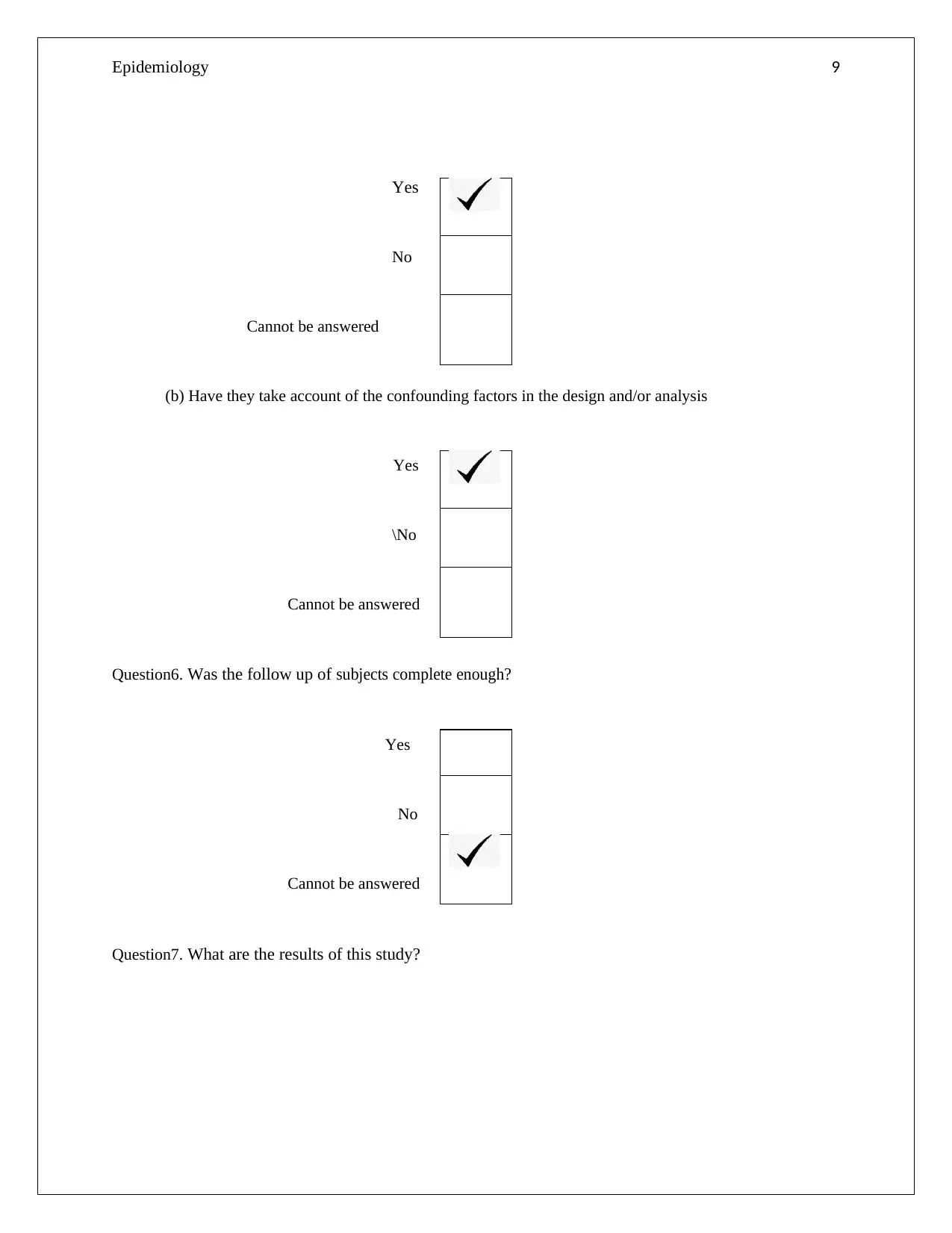
Epidemiology 9
Yes
No
Cannot be answered
(b) Have they take account of the confounding factors in the design and/or analysis
Yes
\No
Cannot be answered
Question6. Was the follow up of subjects complete enough?
Yes
No
Cannot be answered
Question7. What are the results of this study?
Yes
No
Cannot be answered
(b) Have they take account of the confounding factors in the design and/or analysis
Yes
\No
Cannot be answered
Question6. Was the follow up of subjects complete enough?
Yes
No
Cannot be answered
Question7. What are the results of this study?
Paraphrase This Document
Need a fresh take? Get an instant paraphrase of this document with our AI Paraphraser
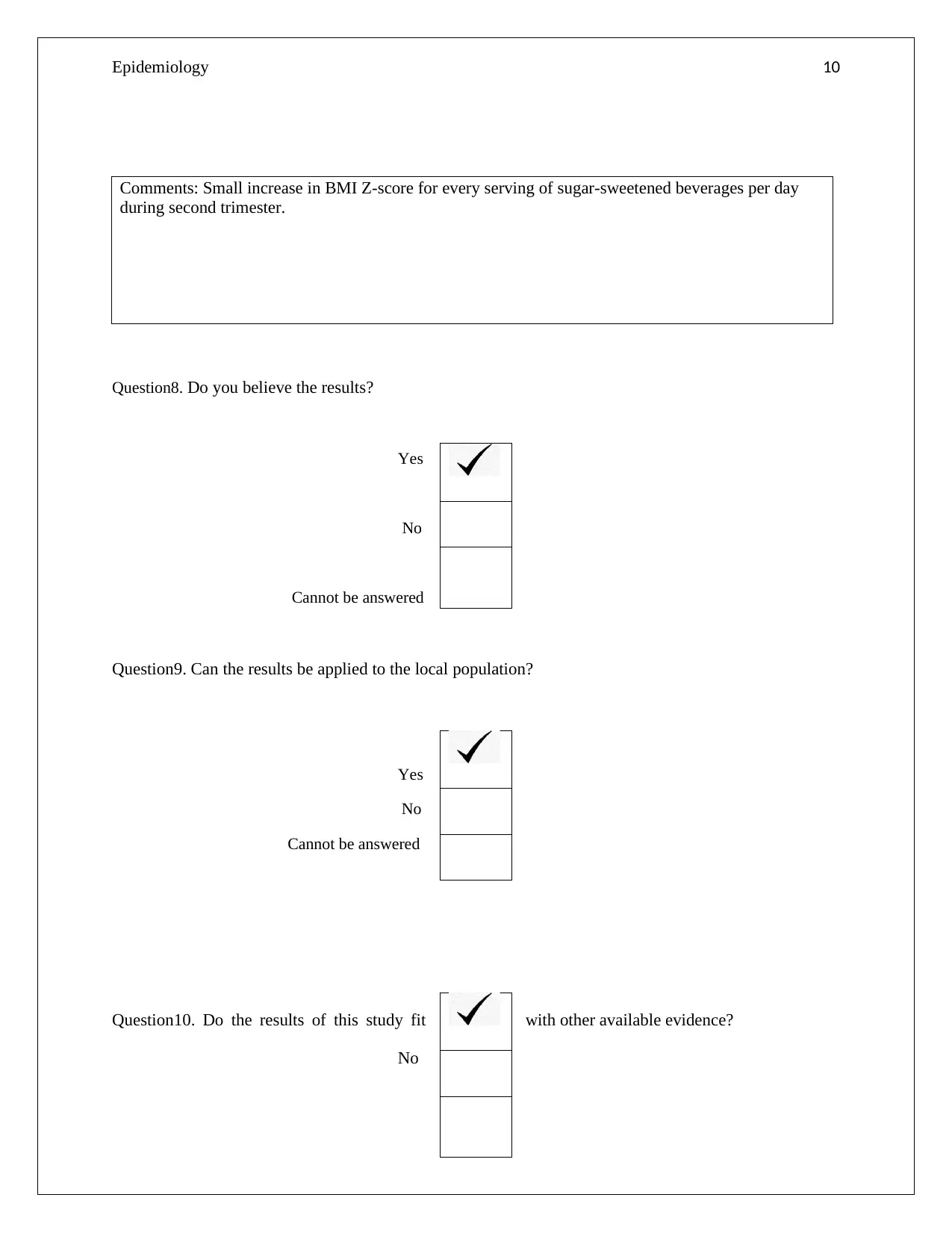
Epidemiology 10
Question8. Do you believe the results?
Yes
No
Cannot be answered
Question9. Can the results be applied to the local population?
Yes
No
Cannot be answered
Question10. Do the results of this study fit with other available evidence?
No
Comments: Small increase in BMI Z-score for every serving of sugar-sweetened beverages per day
during second trimester.
Question8. Do you believe the results?
Yes
No
Cannot be answered
Question9. Can the results be applied to the local population?
Yes
No
Cannot be answered
Question10. Do the results of this study fit with other available evidence?
No
Comments: Small increase in BMI Z-score for every serving of sugar-sweetened beverages per day
during second trimester.
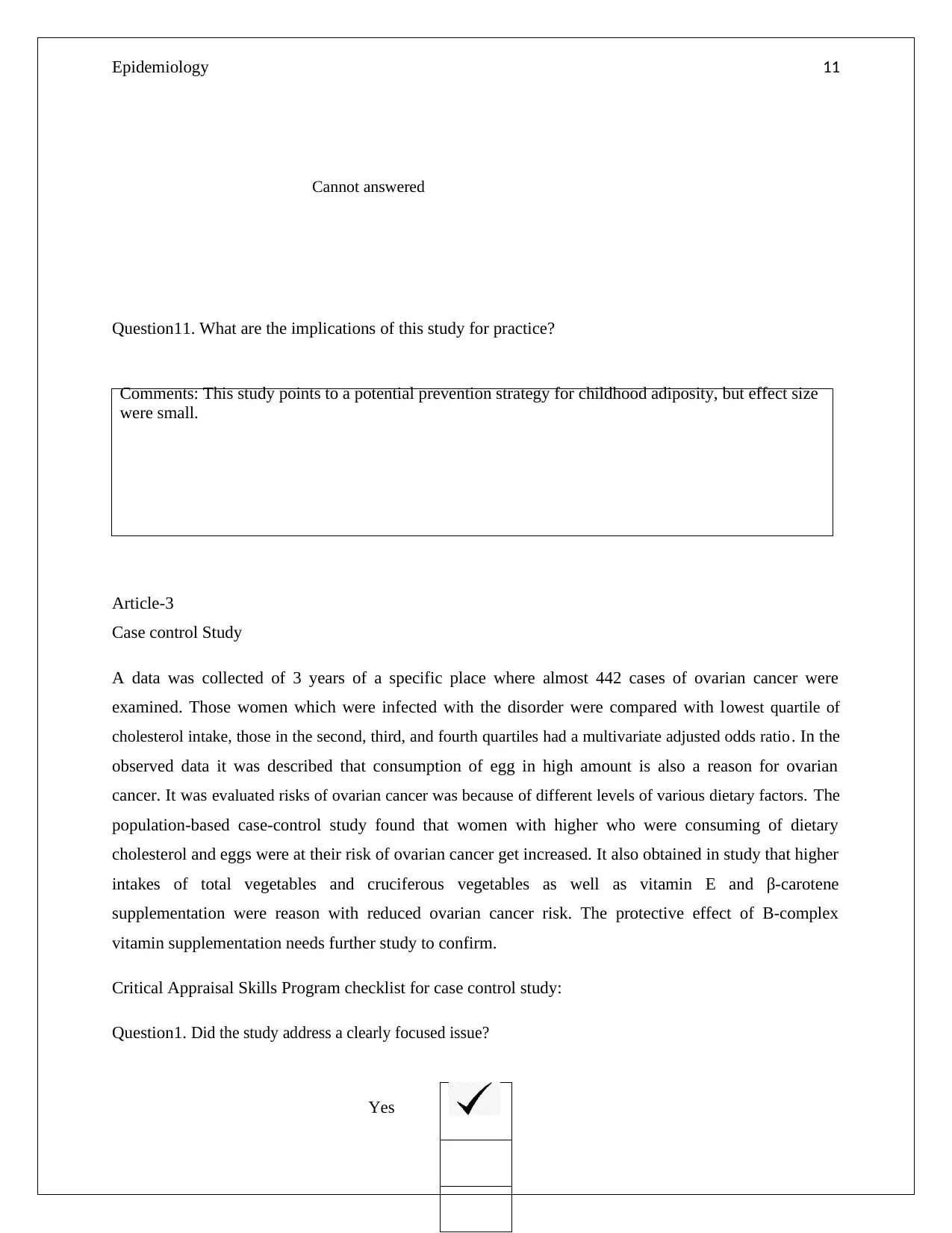
Epidemiology 11
Cannot answered
Question11. What are the implications of this study for practice?
Article-3
Case control Study
A data was collected of 3 years of a specific place where almost 442 cases of ovarian cancer were
examined. Those women which were infected with the disorder were compared with lowest quartile of
cholesterol intake, those in the second, third, and fourth quartiles had a multivariate adjusted odds ratio. In the
observed data it was described that consumption of egg in high amount is also a reason for ovarian
cancer. It was evaluated risks of ovarian cancer was because of different levels of various dietary factors. The
population-based case-control study found that women with higher who were consuming of dietary
cholesterol and eggs were at their risk of ovarian cancer get increased. It also obtained in study that higher
intakes of total vegetables and cruciferous vegetables as well as vitamin E and β-carotene
supplementation were reason with reduced ovarian cancer risk. The protective effect of B-complex
vitamin supplementation needs further study to confirm.
Critical Appraisal Skills Program checklist for case control study:
Question1. Did the study address a clearly focused issue?
Yes
Comments: This study points to a potential prevention strategy for childhood adiposity, but effect size
were small.
Cannot answered
Question11. What are the implications of this study for practice?
Article-3
Case control Study
A data was collected of 3 years of a specific place where almost 442 cases of ovarian cancer were
examined. Those women which were infected with the disorder were compared with lowest quartile of
cholesterol intake, those in the second, third, and fourth quartiles had a multivariate adjusted odds ratio. In the
observed data it was described that consumption of egg in high amount is also a reason for ovarian
cancer. It was evaluated risks of ovarian cancer was because of different levels of various dietary factors. The
population-based case-control study found that women with higher who were consuming of dietary
cholesterol and eggs were at their risk of ovarian cancer get increased. It also obtained in study that higher
intakes of total vegetables and cruciferous vegetables as well as vitamin E and β-carotene
supplementation were reason with reduced ovarian cancer risk. The protective effect of B-complex
vitamin supplementation needs further study to confirm.
Critical Appraisal Skills Program checklist for case control study:
Question1. Did the study address a clearly focused issue?
Yes
Comments: This study points to a potential prevention strategy for childhood adiposity, but effect size
were small.
⊘ This is a preview!⊘
Do you want full access?
Subscribe today to unlock all pages.

Trusted by 1+ million students worldwide
1 out of 29
Related Documents
Your All-in-One AI-Powered Toolkit for Academic Success.
+13062052269
info@desklib.com
Available 24*7 on WhatsApp / Email
![[object Object]](/_next/static/media/star-bottom.7253800d.svg)
Unlock your academic potential
Copyright © 2020–2025 A2Z Services. All Rights Reserved. Developed and managed by ZUCOL.



